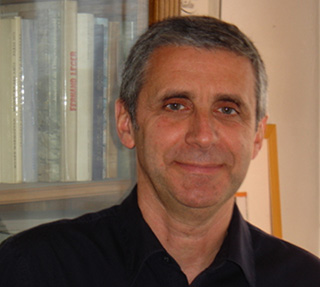
Christian Delage
As a documentary filmmaker, historian and curator, Christian Delage has long consulted with and used video testimonies of Holocaust survivors in his work.
But he is interested in more than just the stories the survivors tell in their testimonies. He’s also fascinated by the process of documentation itself, and even interviewed curators and staff of Holocaust testimony archives including USC Shoah Foundation and Yale’s Fortunoff Video Archive for Holocaust Testimonies four years ago about how the testimonies were conducted over 20 years ago.
One aspect of the process in particular caught his eye and he brought it up with each curator, including staff at USC Shoah Foundation.
“We discussed the fact that in all the instructions, whether at Yale or USC Shoah Foundation, there is always one line saying to the cameraman ‘No editorial comment.’ As if the camera was disturbing the process,” Delage said. “I think without the cameraman there is no mediation.”
This idea of the importance of the camera sums up the two projects Delage will discuss when he travels from Paris to Los Angeles at the end of the month: his traveling exhibit “Filming the Camps: From Hollywood to Nuremberg,” which will begin an eight month installation at the Los Angeles Museum of the Holocaust on August 27, and his new collection of video testimonies of witnesses and survivors of the November 13, 2015 terrorist attacks in Paris, which is the subject of his public lecture at USC on August 31.
USC Shoah Foundation Center for Advanced Genocide Research is a co-sponsor of the LAMOTH exhibit and is co-sponsoring Delage’s talk at USC along with USC Annenberg School for Communication and Journalism and USC Francophone Research and Research Center.
“Filming the Camps,” of which Delage is curator, explores the World War II experiences of Hollywood directors John Ford, George Stevens and Samuel Fuller. The directors each served with the U.S. Armed Forces and Secret Services, filming life on the front lines and the liberation of the Nazi concentration camps. The exhibit includes the film they shot as well as private letters and footage from their personal archives. At LAMOTH, the exhibit will also include artifacts from Samuel Fuller’s family and the 20th Century Fox archives.
The exhibit was first designed, curated and exhibited by the Memorial de la Shoah in Paris and has since traveled around the world. Learn more about the LAMOTH exhibit here.
The footage the directors filmed of the concentration camps is presented almost completely unedited, including the opening claps and end of the reel. Archival responses to the footage, including the filmmakers’ own written reports and comments from writers and scholars, help contextualize and rebuild the original readings of the films.
“You are not directly confronted with the liberation of the camp, but what you see is how the liberation was filmed, the day when they filmed, their comments,” Delage said. “You understand that it’s not a kind of direct account, it’s filtered for you.”
He pointed out that because the handheld 16mm cameras used by the filmmakers only held three minutes of footage on each reel, they had to choose the right moment to begin filming, whenever they thought they could get the best uninterrupted footage. Thus, they were editing as they filmed, careful to only film what they thought would be the most useful.
The camera helped to “protect” the filmmaker, to provide a separation between him and the atrocities he was there to film, which in turn mediates what viewers see as they watch the films today, Delage said.
“You don’t behave the same because you can take a certain distance while filming,” Delage said. “When the audience watches the images today, they have been protected by these cameramen who walked and filmed.”
Delage’s newest project is recording up to 30 interviews with witnesses and survivors of the November 13, 2015 terrorist attacks in Paris that killed 130 people. It is a research program of the Institut D’Histoire du Temps Present, titled “13 November Attacks: Lives That Will Never Be Ordinary Again.”
Working with a team of doctoral students, psychologists, anthropologists and sociologists, Delage interviews not only survivors but also police officers, firefighters, doctors and restaurant and bar owners who witnessed or intersected with the attacks.
The project is an attempt to preserve the history of the attack from the point of view of the survivors and witnesses in a more academic way, as opposed to the news media’s more sensationalized coverage.
Delage said it is a new experience for him to interview people who are so young, and to be less than two years removed from the event.
“When I made interviews with Holocaust survivors, the youngest were 85. I was not born during time they were deported and they were very far from the event they endured,” Delage said. “The average age [of the November 13 survivors] is 33. It’s the first time I’m older than the people I would interview.”
Delage will speak more about the project and show clips from the interviews in his lecture at USC on August 31. Learn more and RSVP here.